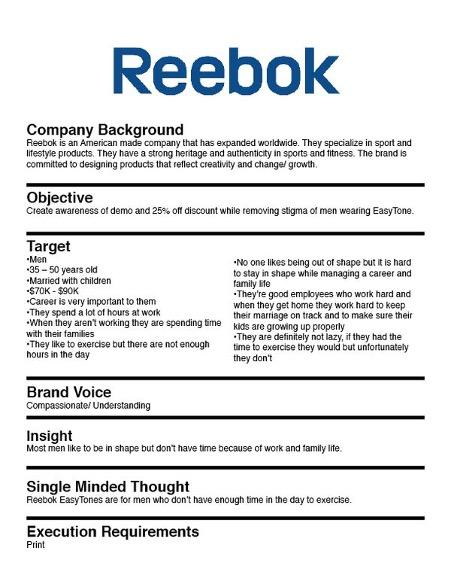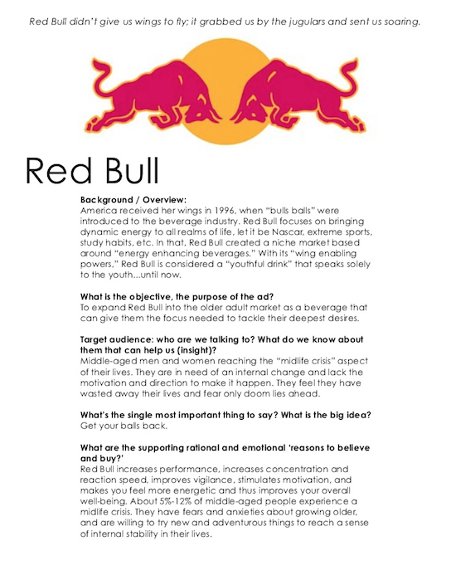Marketing Brief Generator (+ Prompts, Examples, Templates)
A marketing brief is a high-level overview of a marketing project, including its objectives, target audience, and essential details. It serves as a battle plan for marketing teams to all get on the same page before launching a new campaign or project.
Our AI marketing brief generator creates pretty good marketing briefs in just a few minutes. Say goodbye to tedious drafting and endless meetings: just answer a few questions about your marketing product or campaign, and we’ll generate a complete marketing brief, instantly and free.
Prompts for Refining AI Marketing Brief Templates
Once you’ve drafted your marketing brief, use these prompts to polish and perfect it:
- Improve Tone and Style:
“Rewrite this as more formal/playful / etc.” - Expand on Objectives:
“Elaborate on the primary goal of this campaign.”
“Detail the secondary goals and desired outcomes of this marketing initiative.” - Clarify Audience Details:
“Provide a deeper breakdown of the target demographic.”
“Break down our audience segments further; provide insights into their habits or preferences.” - Enhance Competitive Analysis:
“Compare our product to top competitors in the market.” - Get Ideas for Visuals:
“Suggest visual themes that resonate with our brand’s ethos.” - Be Consistent:
“Ensure that this section aligns with our brand voice.”
“Review the ‘Mission Statement’ section to ensure it embodies our brand voice.” - Align Strategy:
“How does this strategy align with our overarching business goals?” - Refine Call-to-Action:
“Suggest three alternative CTAs that might be more compelling.” - Clarify Campaign Duration:
“Specify optimal duration for this marketing campaign.”
“Determine the best campaign length based on our target audience’s engagement trends.” - Review Copy:
“Review and suggest improvements for the copy in the ‘About Us’ section.”
“Analyze the ‘Product Description’ section and recommend areas of improvement.”
Great Examples of Marketing Briefs
Several vital fundamentals must be remembered when developing a marketing brief, regardless of your industry or what you sell. Here are a few marketing briefs that hit the nail on the head.
Reebok
Whether you’re a seasoned runner or like a comfortable pair of shoes to roam around the house in, Reebok is a brand you’ll know well. In this Reebok marketing brief, they’ve covered a few key areas, such as the company background (necessary for setting the scene), the objective (what they are looking to achieve), and their target audience (who they want to focus on). Here’s what it looks like:

Red Bull
From a leading shoe manufacturer to a leading energy drink brand, Red Bull took the world by storm when it went to market. Their brand is synonymous with energy and taking action that “gives you wings.” In their marketing brief, they’ve identified their background, spoken to their objectives, and disclosed their audience. They’ve also included sections on ‘The most important thing to say’ and ‘The supporting and emotional reasons to believe and buy.’ This Red Bull brief outlines what they want to achieve with their marketing collateral.

Coca-Cola
From one drink to the next, Coca-Cola needs no introduction. They have launched many impactful campaigns over several years, with many awards won along the way. One of the ways that they achieved this is by ensuring that their marketing briefs are clear. Here is one such example of a brief from Coca-Cola. It’s focused on a specific target audience: teenagers.

Examples of AI-Generated Marketing Briefs
Example: NexaPoint Tech
This example follows the fictional company NexaPoint Tech, whose mission statement reads:
“NexaPoint Tech exists at the confluence of technology and security, deeply ingrained with the ethos of providing world-class SaaS solutions to industries at the forefront of our digital age. Every beat of our technological heart resonates with a commitment to optimize, secure, and fortify the intricate networks of high-tech sectors—be it government support, healthcare, financial services, or payment processing. In an era where data translates to power and vulnerabilities can spell disaster, NexaPoint Tech is a bulwark of reliability and innovation.”
They want to create a basic marketing brief that outlines their desired marketing approach based on a $50,000 budget.
After completing the questions from the prompt above, this is the result:
Marketing Brief: NexaPoint Tech’s SaaS Solution Campaign
Business Name: NexaPoint Tech
Website: nexapoint.com
Contact: Robert
Product/Service Overview:
Offering: NexaPoint Tech’s Groundbreaking SaaS Solution
Target Customer: Tech Decision-Makers in Enterprise Organizations, Government Support Sectors, Healthcare Institutions, Financial Services, and Payment Processing Companies
Unique Value Proposition (UVP): NexaPoint Tech introduces a cutting-edge SaaS solution tailored for high-demand sectors such as government support, healthcare, financial services, and payment processing. Our product combines advanced network management with fortified security protocols, providing businesses with reliable and high-performance digital infrastructures. However, our true differentiator lies in our robust security features. Our platform offers state-of-the-art security measures in an era of increasing cyber threats, including real-time threat detection and automated response systems. Our proactive approach identifies and patches potential vulnerabilities before they can be exploited.
Campaign Details:
Goals: Brand Awareness
Budget: $50,000
Duration: October 19th, running for six months
Key Message: The core of this campaign is to humanize the technical aspects, making the complex relatable and showcasing the transformative impact of a secure and optimized network.
Channels:
- Social Media (LinkedIn): Engage with tech decision-makers through informative and engaging posts highlighting our SaaS solution’s benefits and network security’s importance.
- Organic Website Content (Blogs, Landing Pages): Publish educational content that simplifies complex technical concepts, demonstrates the value of our solution, and provides actionable insights for businesses.
- Online Videos: Create engaging videos that showcase the features and benefits of our SaaS solution, emphasizing the impact on businesses in high-demand sectors.
- Downloadable Assets (Whitepapers, eBooks, Infographics): Offer valuable resources that delve deeper into network management, security best practices, and the advantages of our SaaS solution.
Key Performance Indicators (KPIs):
- Website Traffic: Monitor the increase in website visits, focusing on unique visitors and the duration of their sessions.
- Social Media Clicks: Track the number of clicks on social media posts, measuring engagement and interest in our SaaS solution.
Recommendations:
- Thought Leadership Content: Publish thought-provoking articles and whitepapers, establishing NexaPoint Tech as an authority in network management and security.
- Customer Success Stories: Share success stories from businesses in high-demand sectors that have benefited from our SaaS solution, highlighting the positive impact on their operations.
- Video Testimonials: Create testimonials featuring satisfied customers who have experienced the advantages of our SaaS solution firsthand.
- Interactive Webinars: Host webinars that educate participants on network security best practices and demonstrate the capabilities of our SaaS solution.
- Optimized Landing Pages: Create dedicated landing pages that provide detailed information about our SaaS solution, its features, and the benefits for businesses in high-demand sectors.
NexaPoint Tech’s SaaS Solution Campaign aims to raise brand awareness by showcasing the transformative impact of a secure and optimized network. By humanizing the technical aspects and providing valuable resources, we position NexaPoint Tech as the go-to solution for businesses in high-demand sectors seeking reliable and secure digital infrastructures.
Harness the power of AI to craft superior marketing briefs with Media Shower. See how it works.
Best Practices for Building a Marketing Brief Template
- Define Clear Objectives: Set measurable campaign goals from the outset.
- Dive into Audience Insights: Deeply segment and understand your target groups.
- Survey the Competition: Understand the market landscape and main competitors.
- Cultivate Brand Consistency: Ensure your brand’s voice resonates throughout.
- Incorporate Relevant Visuals: Use or guide imagery that aligns with your brand.
- Align with Strategy: Ensure your campaign ties to overarching business objectives.
- Set Clear Milestones: Define campaign duration, budget, and key deliverables.
- Iterate from Feedback: Continuously review and adjust based on metrics and insights.
Elevate your content strategy using Media Shower’s proven platform. Click to try us out.

Frequently Asked Questions About Marketing Briefs
What is a marketing brief template?
A marketing brief template provides a structured format to outline your marketing campaign's goals, audience, strategy, and more. It serves as a foundational document guiding the marketing initiative.
Why is a marketing brief important?
It ensures clarity in communication, sets clear objectives, and offers a roadmap for all stakeholders involved. A well-defined brief can significantly enhance campaign effectiveness.
How often should the marketing brief be updated?
Update it as often as campaign objectives, target audiences, or market conditions change. Regular review ensures its alignment with current goals and market realities.
Can I use one template for all marketing campaigns?
While templates provide structure, they should be adapted to each unique campaign. Different campaigns have different needs, objectives, and nuances.
How detailed should my marketing brief be?
It should be detailed enough to provide clarity but concise enough to be easily understood. Aim to balance comprehensiveness and brevity to keep teams aligned and efficient.
Protips for Writing Marketing Briefs
- Objective Clarity: Set precise goals. Anchor every marketing brief around specific, measurable, achievable objectives.
- Audience Insight: Understand your demographics. Invest time in audience research to tailor your messaging effectively.
- Budget Transparency: Allocate funds wisely. Clearly outline budget constraints and allocation to avoid mid-campaign surprises.
- Visual Strategy: Use impactful imagery. Select visuals that align with your brand and resonate with your target audience.
- Timeline Structure: Set clear milestones. Break down your campaign into manageable phases with distinct completion dates.
- Competitor Awareness: Stay updated on rivals. Regularly analyze competitors’ moves to spot opportunities and avoid pitfalls.
- CTA Effectiveness: Drive desired actions. Craft compelling call-to-actions that clearly guide the audience towards your intended outcome.
The Media Shower platform lets you draft great marketing briefs using our AI assistants, then send to our expert creative team to make them into marketing magic. Click for a free trial.


